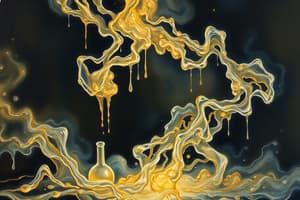Podcast
Questions and Answers
What is a synthesis reaction?
What is a synthesis reaction?
A synthesis reaction occurs when two or more substances combine to form a single new substance.
Provide an example of a synthesis reaction.
Provide an example of a synthesis reaction.
The reaction between sodium (Na) and chlorine (Cl) to produce sodium chloride (NaCl) is a synthesis reaction: 2 Na + Cl2 → 2 NaCl
What are decomposition reactions?
What are decomposition reactions?
Decomposition reactions involve the breakdown of a compound into simpler substances.
Differentiate between synthesis and decomposition reactions.
Differentiate between synthesis and decomposition reactions.
Describe the general equation for a synthesis reaction.
Describe the general equation for a synthesis reaction.
What is the general equation for a decomposition reaction?
What is the general equation for a decomposition reaction?
Provide an example of a single replacement reaction and its general equation.
Provide an example of a single replacement reaction and its general equation.
Explain the concept of balancing chemical equations and why it is important.
Explain the concept of balancing chemical equations and why it is important.
Define redox reactions and provide an example.
Define redox reactions and provide an example.
What does chemical kinetics focus on, and what factors does it study?
What does chemical kinetics focus on, and what factors does it study?
Flashcards are hidden until you start studying
Study Notes
Chemical Reactions and Equations
Chemical reactions are fundamental processes that involve the transformation of substances from one state to another, often accompanied by the release or absorption of energy. These reactions can be classified into several types, each with its unique properties and characteristics. In this article, we will explore the main types of chemical reactions, including synthesis (combination), decomposition, single replacement (single displacement), double replacement (double displacement), and combustion (oxidation).
Types of Chemical Reactions
Synthesis (Combination) Reactions
Synthesis reactions, also known as combination reactions, occur when two or more substances combine to form a single new substance. This type of reaction is represented by the general equation:
A + B → AB
For example, the reaction between sodium (Na) and chlorine (Cl) to produce sodium chloride (NaCl) is a synthesis reaction:
2 Na + Cl2 → 2 NaCl
Decomposition Reactions
Decomposition reactions are the opposite of synthesis reactions. They involve the breakdown of a compound into simpler substances. These reactions are usually endothermic, meaning they require an input of energy. The general equation for decomposition reactions is:
AB → A + B
For example, the decomposition of mercury (II) oxide (HgO) to form mercury (Hg) and oxygen (O2) is a decomposition reaction:
2 HgO → 2 Hg + O2
Single Replacement (Single Displacement) Reactions
Single replacement reactions, also known as single displacement reactions, occur when one element replaces another element in a compound. This produces two new compounds. The general equation for single replacement reactions is:
A + BC → AB + C
For example, the reaction between tin (Sn) chloride (SnCl4) and zinc (Zn) to produce zinc chloride (ZnCl2) and tin (Sn) is a single replacement reaction:
SnCl4 + Zn → ZnCl2 + Sn
Double Replacement (Double Displacement) Reactions
Double replacement reactions, also known as double displacement reactions, involve the exchange of ions between two compounds to form two completely new compounds. The general equation for double replacement reactions is:
AB + CD → AC + DB
For example, the reaction between silver (Ag) nitrate (AgNO3) and potassium (K) chloride (KCl) to produce silver chloride (AgCl) and potassium nitrate (KNO3) is a double replacement reaction:
AgNO3 + KCl → AgCl + KNO3
Combustion (Oxidation) Reactions
Combustion reactions, also known as oxidation reactions, involve the combination of a substance with oxygen (O2) to produce a new substance and release energy. The general equation for combustion reactions is:
C + O2 → CO2
For example, the combustion of methane (CH4) to produce carbon dioxide (CO2) and water (H2O) is a combustion reaction:
CH4 + 2 O2 → CO2 + 2 H2O
Balancing Chemical Equations
Balancing chemical equations is an essential skill in chemistry. It involves adjusting the coefficients in a chemical equation to ensure that the number of atoms of each element is the same on both sides of the equation. This ensures that the reaction is stoichiometrically balanced.
Redox Reactions
Redox reactions, short for reduction-oxidation reactions, are a special class of chemical reactions in which one substance is reduced (loses oxygen or gains electrons) while another substance is oxidized (gains oxygen or loses electrons). These reactions can be represented as the sum of an oxidation reaction and a reduction reaction.
Chemical Kinetics
Chemical kinetics is the branch of chemistry that deals with the rates of chemical reactions and the factors that influence these rates. It involves the study of reaction rates, reaction mechanisms, and the effects of temperature, pressure, and concentration on reaction rates.
In conclusion, a thorough understanding of chemical reactions and their classification, balanced equations, redox reactions, and kinetics is crucial for a deep comprehension of chemistry. By examining these topics, we can gain valuable insights into the fundamental principles that govern the behavior of matter at the molecular and atomic levels.
Studying That Suits You
Use AI to generate personalized quizzes and flashcards to suit your learning preferences.




